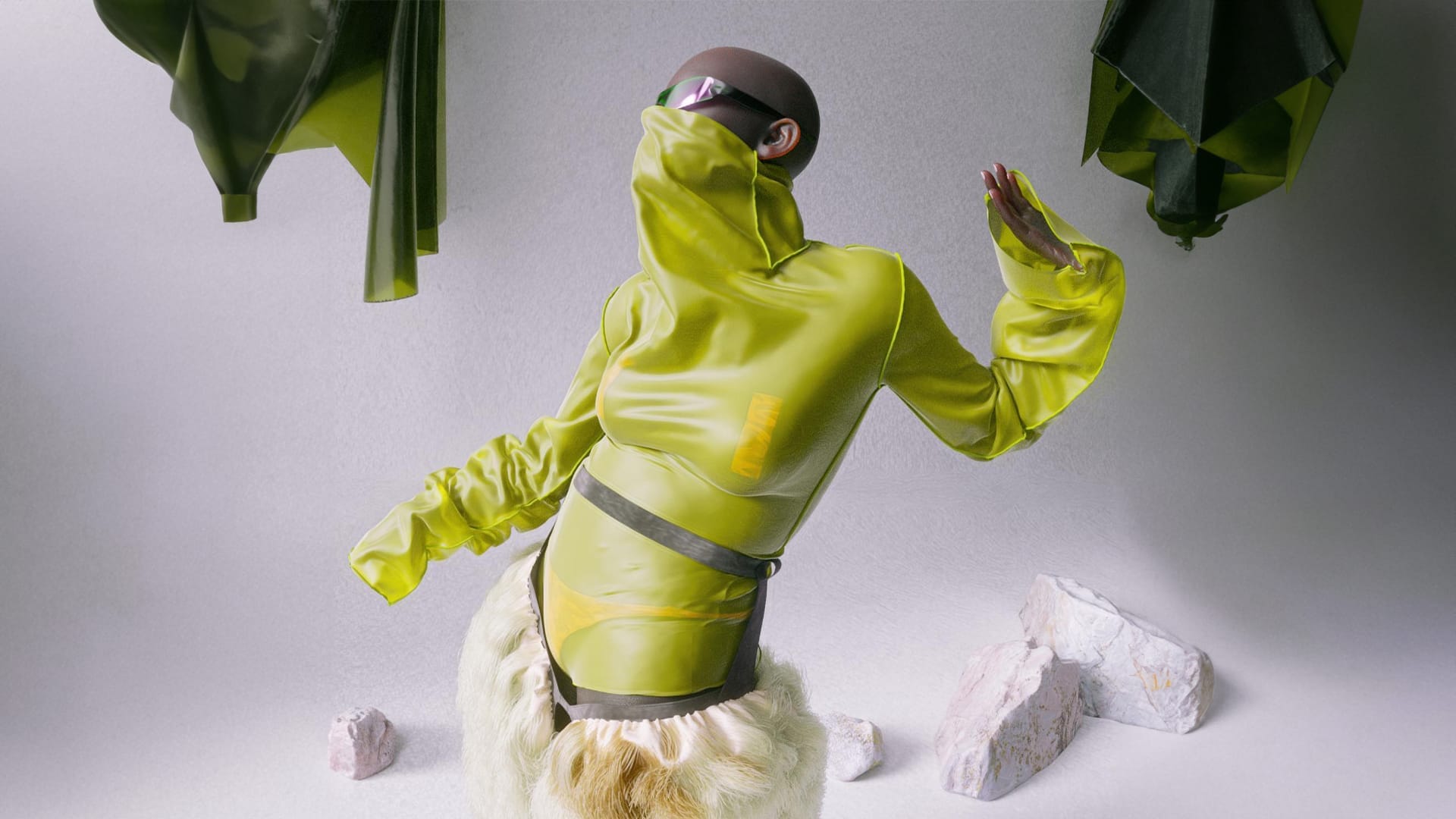
Weaving Technology into the Future of Fashion and Identity
As we witness a transformative shift in the fashion landscape, a shift driven by groundbreaking technological advancements and creative breakthroughs — Today, fashion transcends its traditional confines. It’s becoming increasingly personalized and diverse, thanks to the mainstream adoption of Non-Fungible Tokens (NFTs).
The advent of Web 3.0 marks the beginning of an era characterized by extraordinary personalization in shopping experiences. It’s a time where fashion is meticulously tailored to individual preferences and measurements with remarkable precision.
In this dynamic and evolving backdrop, visionaries like DressX, XR Couture, Digitalax, The Fabricant, and SYKY emerge not merely as participants but as the architects of this digital fashion revolution. Each of these entities is making unique contributions to a rapidly expanding domain where digital identity and physical attire are becoming increasingly intertwined.
The following article explores how digital fashion led by innovators like these are forging new paths in the fashion industry, blending the virtual with the real, ultimately redefining our perceptions of style, expression, and sustainability for the digital age.
DEEP into the UNKNOWN.
— The Fabricant - DEEP dropping Dec 20 (@thefabricant) December 13, 2023
We asked the question, can computers be creative? What happens when a computer and a human work together to design a collection?
Style unknown, creativity redefined.
1st look in DEEP dropping Dec 20, 2023.
🔗View collection https://t.co/JRMbxLNWXf pic.twitter.com/J2FZctzXfR
A Retrospect : The Birth and History of Digital Fashion
Before discussing the development of digital fashion, it’s crucial to first understand what digital fashion is. Digital fashion refers to garments and accessories that are created and used in purely digital environments.
Digital fashion is often showcased in virtual worlds – in other words, the metaverse – online platforms, and through augmented reality, allowing users to ‘wear’ these garments in a digital context. It’s a field that intersects fashion design, technology, and digital art, offering new forms of expression and creativity.
And as we increasingly engage in these digital spaces, digital fashion has become one of the most important forms of artistic expression, blurring the line between the virtual and the physical.
The birth and history of digital fashion is marked by significant milestones that showcase its evolution from a niche concept to a mainstream phenomenon:
Early 2000s: The journey of digital fashion began with the development of 3D design software, initially used for creating digital prototypes of physical garments.
2018: A major breakthrough occurred when Carlings, a Scandinavian retailer, introduced the world’s first digital-only clothing collection. This innovative step involved selling digital garments that were edited onto customers’ photos, making a strong statement in the digital fashion space.
2018-2019: Gucci, the renowned Italian luxury brand, started experimenting with augmented reality experiences and collaborated with Genies, a company specializing in avatars, allowing users to dress their digital selves in Gucci outfits.
2019: Carlings launched the “Last Statement T-Shirt,” a unique augmented reality graphic tee. This tee used Spark AR technology, enabling users to change its graphic design through a smartphone, aligning with the growing trend of sustainable fashion.
2019: The digital-only couture piece “Iridescence” by The Fabricant was sold for $9,500 at an auction. This sale was a pivotal moment, highlighting digital fashion as both a valuable art form and a collectible commodity. The same year, Moschino, in collaboration with The Sims, created a ready-to-wear collection that paid homage to the life simulation game, allowing players to dress their in-game characters in Moschino designs.
2020: Marc Jacobs partnered with Animal Crossing, showcasing collections in the game, a response to the inability to hold physical fashion shows during the pandemic. This collaboration highlighted the growing intersection of fashion and gaming. Not to mention the runways of other brands experimenting with the Metaverse, for instance Decentraland.
Recent Developments: Brands like Nike and Rebecca Minkoff have recognized the potential of digital fashion, with Nike acquiring RTFKT in 2021 and launching CryptoKicks to name a few of the most iconic developments that are reaching the mainstream.
These milestones not only reflect the technological advancements but also the cultural shift towards embracing digital identities and sustainable fashion practices.
Ending Tomorrow. INTERLôR VOL. 1: Awaken by @GLITCHOFMIND.
— SYKY (@the_SYKY) December 9, 2023
Open Mint & auction for @GLITCHOFMIND digital couture collection closes tomorrow, December 10th at 12pm EST.
Discover INTERLôR VOL. 1: Awaken exclusively on https://t.co/6ybyuzOlrU.#SYKY #TheSYKYCollective #INTERLoR pic.twitter.com/0yvnX3WnSB
The Web 3.0 Transformation: Tailoring the Future of Fashion
As one of the most impactful innovations in the digital fashion landscape, Web 3.0 signals the start of a new era marked by decentralized, blockchain-based technologies. This transformation goes beyond just altering digital interactions with fashion; it’s reshaping the very infrastructure of the industry, from supply chains to customer engagement, introducing profound changes in how we understand and interact with fashion.
At the core of Web 3.0’s influence is its ability to enhance traceability and sustainability, particularly through the innovative use of blockchain technology. This advancement brings unprecedented transparency to supply chains, enabling both consumers and brands to meticulously track a product’s journey from its raw materials to its final placement on the retail shelf. Such transparency not only champions ethical manufacturing practices but also propels the fashion industry towards more sustainable practices.
Furthermore, when it comes to fashion resale, NFT technology is becoming increasingly crucial, particularly in addressing authentication challenges. By clearly distinguishing between original and counterfeit products, NFTs instill a heightened level of trust and authenticity, benefiting both buyers and sellers.
Additionally, digital fashion brands are leveraging the possibilities of Web 3.0 to offer unprecedented levels of customization and personalization. Forerunners like The Fabricant are introducing unique, digital-only garments, customizable to individual tastes and styles – a level of personalization previously unimaginable in traditional fashion retail.
Moreover, the rise of Decentralized Finance (DeFi) marks a significant shift in the fashion industry’s economic framework. By offering alternative financing sources, DeFi is especially beneficial for independent designers and new brands, providing them with the necessary capital to innovate and create outside the constraints of traditional financial institutions.
In summary, Web 3.0 represents more than a technological evolution, it is emopowering designers and transforming supply chains, ultimately redefining our relationship with fashion into something more personalized, sustainable, and authentic.
GM, are you wearing #digitalfashion today?
— DRESSX (@dressxcom) December 15, 2023
Link below 👇 pic.twitter.com/7Y1CuQ7qkp
Innovators at the Forefront: Sculpting the Digital Fashion Universe
As we navigate through the digital fashion revolution, a select group of visionaries are redefining the very fabric of this industry. DressX, XR Couture, Digitalax, The Fabricant, and SYKY are not just riding the wave of change; they are the ones creating it. Their work transcends the traditional paradigms of fashion, weaving a new narrative that intricately blends our digital personas with our physical reality. In this realm, fashion is not merely a commodity but an extension of our digital ethos, a complex interplay of identity, creativity, and technology.
DressX has emerged as a leader in digital clothing, offering virtual outfits that blend digital art with fashion. This approach challenges the conventional fashion consumption model, heralding a sustainable future where the production of physical garments may no longer be the norm.
XR Couture is transforming fashion consumption through immersive AR and VR experiences. Their platform allows users to not only visualize but also interact with digital fashion in new and exciting ways, pushing the boundaries of personal style and expression.
Digitalax combines fashion with blockchain, leading the charge in the digital-only clothing market. Their use of NFTs for authenticating and trading digital garments is creating a new digital fashion economy, where ownership and exclusivity are redefined.
The Fabricant is known for their digital couture, particularly for their groundbreaking sale of “Iridescence.” This event was not just a commercial success; it showcased digital fashion’s potential as both an art form and a valuable commodity.
SYKY is carving out its niche by focusing on the confluence of technology and style. Their platform is more than a showcase for digital fashion; it’s a community hub for creators and consumers who are passionate about the future of fashion.
By seamlessly integrating cutting-edge technologies like AR, VR, and blockchain with the timeless art of fashion, they are not just creating a new market – these digital fashion leaders are cultivating a new cultural lexicon.
They are redefining the very way we perceive and interact with the world around us, blurring the lines between the tangible and the virtual, the real and the imagined.
Experience #fashion history like never before as @gucci brings its London exhibit to life on @TheSandboxGame✨❤️🔥
— XR Couture (@XRCouture) November 10, 2023
“Gucci Cosmos Land” is not just a game; it’s a portal to Gucci’s past, present, & future!
⚠️Limited Edition>ends 11/22/23. Don’t miss out🚀#DigitalFashion #Gucci pic.twitter.com/zJpKEykJlD
Fashion as Digital Art: Redrawing the Boundaries of Creativity and Identity
Exploring the depths of the digital fashion revolution, led by innovators like DressX, XR Couture, Digitalax, The Fabricant, and SYKY, it’s becoming increasingly clear that this evolution is more than just a technological advancement. It represents a profound cultural shift, altering the very fabric of how we view art, fashion, and identity.
The conventional borders of art are being reimagined: the fusion of 3D modeling, augmented reality, and blockchain within the realm of fashion design has given rise to an entirely new artistic dialect. This language is not confined to discussions of style; it extends into the realms of storytelling and personal identity. Digital garments have become a canvas for self-expression and societal discourse, transcending their role as mere articles of clothing.
This shift in cultural perception is significant, with its influence reaching far beyond the confines of the fashion industry. It challenges and redefines our societal understanding of art and identity, casting a new light on the relationship between the creator, the wearer, and the observer. Fashion is an integral part of our digital persona, a crucial element in how we construct and perceive our identities in the digital world.
This shift is not just about new styles or technologies; it’s about a fundamental change in how we express ourselves and interact with the world around us. Digital fashion is at the forefront of this cultural metamorphosis, heralding a future where the fusion of technology, art, and identity opens up new horizons of creativity and personal expression.
The encrypted wardrobe: Access Granted 🔐
— DIGITALAX | digicore.eth // digitalax.lens (@DIGITALAX_) September 20, 2023
Apparel live on LitListener Storefront. pic.twitter.com/UueBeOh74I
fakewhale
Founded in 2021, Fakewhale advocates the digital art market's evolution. Viewing NFT technology as a container for art, and leveraging the expansive scope of digital culture, Fakewhale strives to shape a new ecosystem in which art and technology become the starting point, rather than the final destination.
You may also like
Zombie Curating in the Infrathin of the Now. Beyond the ‘Curatorial’
In my white-cube bedroom, I notice how cold and impersonal such a space can get. Books are few and f
Luciana Lamothe “Folding Roads” at Galleria Alberta Pane, Venice
“Folding Roads” by Luciana Lamothe, curated by Ilaria Gianni, at Alberta Pane Gallery, V
FW Spotlight: Top Submissions of November
“Art is not just about reflecting the world but changing it,” says a famous quote by Ola




